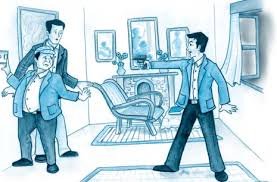- NCERT Solutions for Class 10 English ‘ The Midnight Visitor ‘
- Importent FAQs on The Midnight Visitor
- 2. Who is Fowler and what is his first authentic thrill of the day?
- 1. How has Max got in?
- 1. “Ausable did not fit any description of a secret agent Fowler hand ever read.” What do secret agents in books and films look like, in your opinion? Discuss in groups or in class some stories or movies featuring spies, detectives, and secret agents, and compare their appearance with that of Ausable in this story. (You may mention characters from fiction in languages other than English. In English fiction, you may have come across Sherlock Holmes, Hercule Poirot, or Miss Marple. Have you watched any movies featuring James Bond?)
- 2. How does Ausable manage to make Max believe that there is a balcony attached to his room? Look back at his detailed description of it. What makes it a convincing story?
- 3. Looking back at the story, when do you think Ausable thought up his plan for getting rid of Max? Do you think he had worked out his plan in detail right from the beginning? Or did he make up a plan to take advantage of events as they happened?
- 1. In this story, Ausable shows great ‘presence of mind’ or the ability to think quickly and act calmly and wisely, in a situation of danger and surprise. Give examples from your own experience, or narrate a story, which shows someone’s presence of mind.
- Also Visit eStudyzone for English Medium Study Material
NCERT Solutions for Class 10 English ‘ The Midnight Visitor ‘

1. How is Ausable different from other secret agents?
Ans: Ausable was different from other secret agents in more ways than one. He had a small room in the musty corridor of a gloomy French hotel. It was on the sixth and top floor and it was scarcely the setting for a romantic adventure. He was extremely fat. Despite living in Paris for over twenty years, he spoke French and German only passably and had an American accent. Instead of getting messages slipped into his hands by dark-eyed beauties, he got only a telephone call to make an appointment. In these ways, he was different from the conventional notion of a spy.
2. Who is Fowler and what is his first authentic thrill of the day?
Ans: Fowler was a writer and he had come to meet Ausable. Fowler’s first authentic thrill of the day came when he saw a man in Ausable’s room pointing a pistol toward Ausable and himself.
1. How has Max got in?
Ans: Max had got into the room with a passkey or a master key.
2. How does Ausable say he got in?
Ans: Ausable said that he thought Max had gotten into the room through the balcony. He said that it was the second time in a month that somebody had gotten into his room this way.
1. “Ausable did not fit any description of a secret agent Fowler hand ever read.” What do secret agents in books and films look like, in your opinion? Discuss in groups or in class some stories or movies featuring spies, detectives, and secret agents, and compare their appearance with that of Ausable in this story. (You may mention characters from fiction in languages other than English. In English fiction, you may have come across Sherlock Holmes, Hercule Poirot, or Miss Marple. Have you watched any movies featuring James Bond?)
Ans: Secret agents in fiction are projected like ideal men, ‘Tall dark, and handsome’. They are usually well-built and keep beautiful women for company. They would always smoke pipes or cigars and do death-defying stunts. James Bond is a very famous character by Ian Fleming. Movies based on James Bond show hi-tech gizmos which assist the detective in countering villains. There are some exceptions as well. There is a character named Feluda which was created by Satyajit Ray, the famous Bangla Filmmaker. Feluda was a typical bhadralok by appearance.
2. How does Ausable manage to make Max believe that there is a balcony attached to his room? Look back at his detailed description of it. What makes it a convincing story?
Ans: Ausable tells Max that someone entered his room through the balcony before also. He also told him that he had asked the police to give him protection as he had some important papers with him. On listening Max became nervous and just wanted to escape from the police, as a result without noticing he jumped out of the window and fell. Ausable’s ability to think quickly and calmly, in a situation of panic makes it convincing.
3. Looking back at the story, when do you think Ausable thought up his plan for getting rid of Max? Do you think he had worked out his plan in detail right from the beginning? Or did he make up a plan to take advantage of events as they happened?
Ans: No, I don’t think that he had worked out his plan in detail. He took advantage of the events as they happened. Ausable made a story of the balcony outside the room and as there was a knock at the door, he told it would be the police, all these events threatened Max. In such a hurry, he became restless and without seeing jumped out of the window.
1. In this story, Ausable shows great ‘presence of mind’ or the ability to think quickly and act calmly and wisely, in a situation of danger and surprise. Give examples from your own experience, or narrate a story, which shows someone’s presence of mind.
Ans: This story is a reference to the play ‘If I Were You’. Gurrad was captured by a criminal and the criminal pointed the gun towards him but he treated the criminal as a guest and trapped him in his confidence. He made the criminal run away as the police were behind him. He told the criminal to run through the exit door, which was a cupboard door. The criminal exited through the door and was caught in the cupboard.
https://readspot.in/chapter-4-3/
Also Visit eStudyzone for English Medium Study Material




